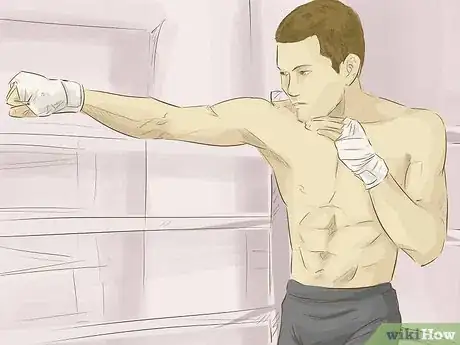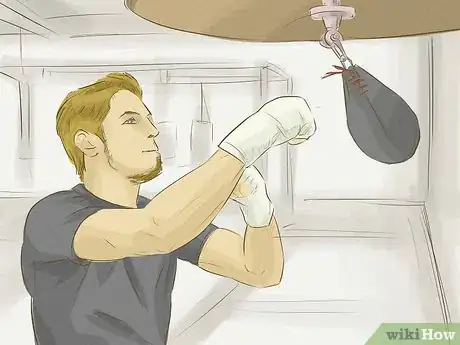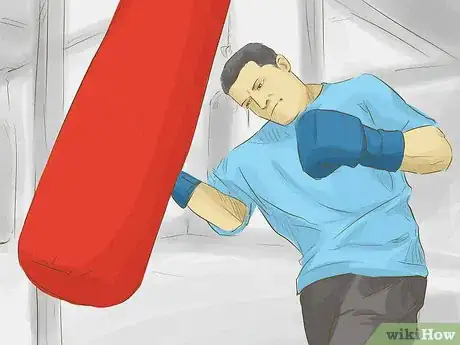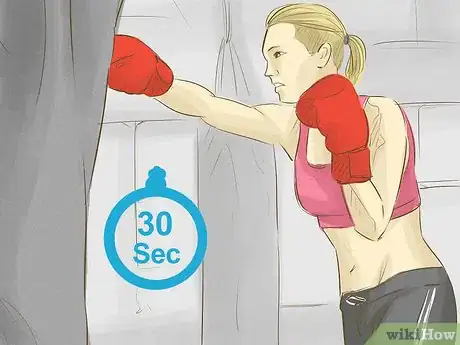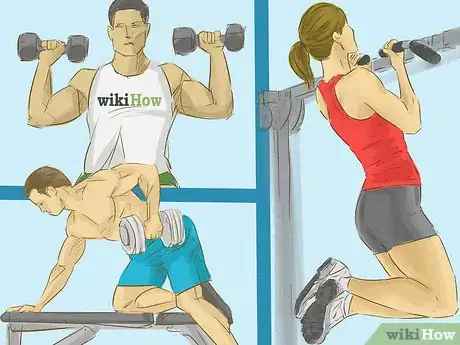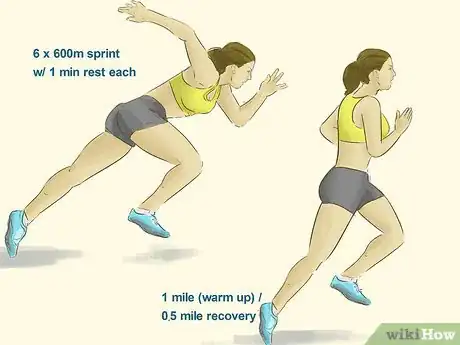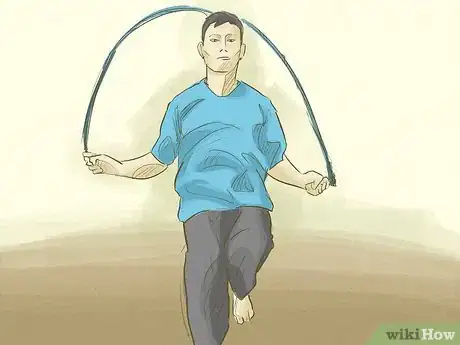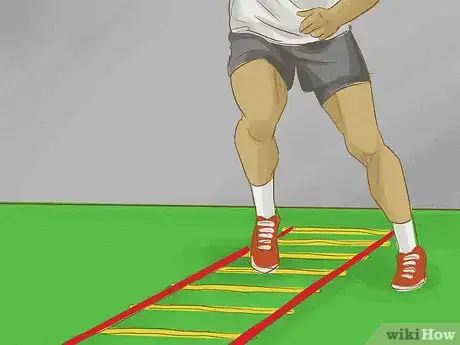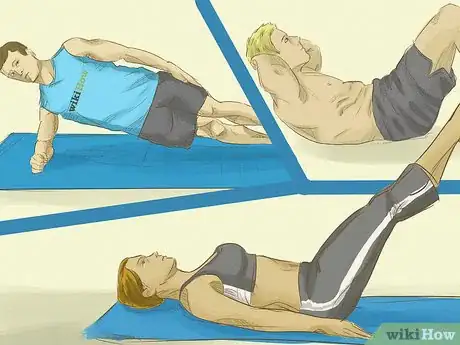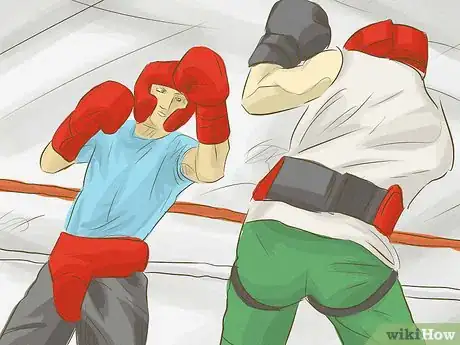This article was co-authored by David Engel. David Engel is a Muay Thai Instructor and Self Defense Trainer based in the San Francisco Bay Area. With over 15 years of martial arts instruction and training experience, David runs California Martial Athletics with co-owner Joe Chernay. He has created and maintained martial arts programs at Rise Combat Sports in San Francisco and Round 5 Martial Arts Academy in San Leandro, with a mission to provide students with a level of comfort and competency that manifests both within and outside the martial arts context. He is also a registered cornerman for amateur and pro competitors under the IKF (International Kickboxing Federation). David was the youngest apprentice instructor of the Thai Boxing Association of America under Ajarn Chai Sirisute (2009), and was a top-ranked amateur competitor in his weight class (127-130 lb) in California between 2013 and 2015.
There are 10 references cited in this article, which can be found at the bottom of the page.
wikiHow marks an article as reader-approved once it receives enough positive feedback. This article received 39 testimonials and 86% of readers who voted found it helpful, earning it our reader-approved status.
This article has been viewed 1,087,707 times.
Training to become a boxer takes effort, discipline, and self-confidence. When you are seriously considering boxing as a career you need to join a gym and find a trainer. However, beginners can train themselves when they cannot afford to see a trainer. In general, a serious boxer should expect to train for 3-5 hours, 3-5 times a week.[1]
Steps
Hand Training
-
1Focus on your punching technique to improve power and endurance. Good punches are efficient punches, transferring power to your opponent with grace and ease. While you should work on training your speed and endurance, better technique will always lead to a better boxer. While doing the following drills, focus on:
- Leading with your elbow. Think of throwing your elbow at your opponent, not your wrist.
- Staying compact. You don't want to flail or move your body unnecessarily. Keep your non-punching hand close and your legs sturdily underneath you.
- Letting your arms rest and move during breaks. When you're not punching, leave your arms loose, or "breathing," so that they rock comfortably with your body. Don't try and clench and hold them rigidly-- it will only tire you out faster.[2]
-
2Focus on smooth, clean speed bag drills. Speed bags hang from the ceiling and require you to develop a strong, consistent rhythm to your punches. You hit with a regular, circular motion, keeping your hands and the bag moving. This is one of the best ways to build your endurance, connection, and coordination with your hands.
- Run the speed bag for 3-5 3-minute sessions, resting 30 seconds between each interval.
Advertisement -
3Hit the heavy bag for 3-minute intervals 3-5 times each training session. The heavy bag (the enormous hanging bag for punch training) is going to become your best friend. You want to hit it for 3-5 minutes, punching like you would in a fight. However, make sure you're not just standing there trying to hit. Stay on the balls of your feet, keep moving like in a real fight, and stop occasionally to duck, dodge, and block, like you would in a real fight. In general, the more like the real thing you can make it, the better the workout will be.[3]
- For a more tiring workout, give the bag a swing before beginning. This forces you to focus in on a moving target.
-
4Try out 30-second punching "sprints" to build arm endurance. Using a heavy bag, take 30 seconds to throw as many punches as you possibly can. Focus on speed, not power, as you throw the punches. After 30 seconds, rest for 30 seconds and then repeat 4-5 more times.
-
5Begin a strength training regime. You can choose to lift or simply use your body weight to build muscle. No matter what your style, mix in 2-3 days of strength training every week, cutting down to 1 on fight weeks. Luckily, boxing is so muscle intensive that you will be making gains each time you spar, fight, or shadowbox as well, so strength training should not be the focus of your workouts. Aim for big, multi-muscle exercises to build the most muscle the fastest. Some good exercises to try include:
-
Body weight: If you can't go to the gym, are under 16 years old, or just would rather not lift weights, there are plenty of great exercises to try:
- Push-ups, close-handed and wide stance.
- Dips
- Do front and side planks.
- Try body-weight rows, or inverted rows.
- Pull-ups and chin-ups.
- Weight lifting: Focus on smooth, fluid technique. You want to move both up and down with control for the safest, best results.
-
Body weight: If you can't go to the gym, are under 16 years old, or just would rather not lift weights, there are plenty of great exercises to try:
-
6Try slow sparring. A great tool for beginners, slow sparring takes all of your work into the ring for a safe, technique focused exercise. It is just like normal sparring with a partner, but you want to throw punches at 75% of your normal speed. This is the best way to work up your opposite hand, focus on techniques or moves that you don't have down yet, and build up confidence in the ring. Since you have to react to a live fighter, even at a slow pace, this is a great way build essential skills.
- Focus on coordination -- follow through on your punches, keep your feet moving, and focus on hand positioning in all circumstances. All of your body parts should be moving in concert with one another.[5]
Foot Training
-
1Do interval training 2-3 times a week. The classic long runs seen on Rocky are not actually great training for boxing. Boxing is about short, sustained bursts of high energy, and the best way to train for this is interval training. Intervals are when you alternate high energy, quick sprints with short rest periods. As you get fit you can shorten the rest periods by 10-15 seconds, improving your gains even more. A good starter workout would be:
- 1-mile warm up at slow, easy jogging pace.
- Six 600m sprints, resting for 1 minute between each. You want to be running at roughly 75-80% of your top speed.
- .5 mile slow, easy recovery jog at the end.[6]
-
2Mix in long runs, shadow boxing, and short sprints on non-interval days. Interval training will make up the bulk of your cardio workouts, and they are the best way to quickly and effectively train for several explosive rounds of boxing. However, you still want to move your legs on the off days. The best way to do this is with a mixture of full body workouts, longer, slower distance runs, and some light, quick sprints.[7] The following activities, used at the US Olympic training camps, should be mixed and matched into a 30-60 minute long workout:
- 1-2 mile run for warm-up (moderate to fast pace).
- Shadowbox 1 round (3-minute round).
- Run backward 200 meters.
- Sprint 100 meters.
- Jog with hands up, throwing realistic punches, for 400 meters.[8]
-
3Pepper in 1-2 long, slow distance runs each week to rest and stretch your legs. The classic 4-5 mile morning run still has its place in boxing training. Use it on days where you need to recover, especially after 2-3 straight days of intense workouts. Longer, slower runs are also best in the days leading up to a fight, as you don't want to be sore and tired when you step in the ring. Run for 30 minutes to an hour at a nice, comfortable pace, and stretch before and after.[9]
- Many trainers recommend doing your runs first thing in the morning, giving you time to refuel and rest for the skills workout later on.
- As you jog, keep your hands in defensive position, occasionally throwing mock punches, to get your arms warmed up. This is why most boxers call running "roadwork."
-
4Jump rope every day you train. Jumping rope is one of the most fantastic boxing workouts imaginable, strengthening your heart, agility, timing, and coordination. You should aim to fit 15 minutes of jump rope into every workout. Start with the basic jogging technique, alternating feet as you spin the rope. As you improve, try alternate, more technical foot patterns:
- Jump with both feet together.
- Cross your hands. As the rope is coming down, past your nose, cross your wrists over each other, then uncross them once the rope is passed your feet.
- Move as you jump. "Walk" forwards, backward, and side to side by hopping around as you jump.
-
5Work on agility drills, like ladders and quick cuts. Ladder drills are common in gyms across the world, and can be adapted easily into a variety of workouts. To do them, set up cones or a workout ladder, and focus on quickly moving your feet through ever single space. As you progress, mix up the routine by skipping every other foot, touching in each space 2 times, working in and out of the ladder forward and backward, etc.
- Ladder workouts are common in many sports, and you should constantly try new movements.
-
6Focus on good footwork technique. Having good footwork is not just about training your heart and lungs. To be a better boxer, you need to train with good form so that you don't think about your feet during a fight. When working on footwork, focus on:
- Staying on the balls of your feet. These are the "knobs" right before your toes. This makes pivoting, moving, and shifting much easier.
- Keep your spine straight. Avoid hunching or leaning back. This keeps your center of gravity even and allows for smoother movement.
- Relax your upper body. You want loose shoulders and pecs.[10]
Fight Training
-
1Make sure your diet consists only of healthy foods. Choose proteins as the basis of your diet, and eliminate high-calorie junk like fried foods, cakes, creams, butters, and sugars. Drink plenty of water each day. The more water you take in, the better it will be for your body. A good meal might include:
- Lean proteins, like eggs, fish, and chicken, are essential.
- Good, unsaturated fats, found in fish, avocados, and nuts.
- Complex carbohydrates, like pasta, whole wheat, and quinoa, instead of white rice, white bread, and other simple sugars.
- If you're thirsty, at any point in the day, get some water. If you're drinking to keep thirst at bay, you're well hydrated.[11] Make sure you always have a lot of water available when training.
-
2Shadowbox by yourself in the ring. Shadowboxing is just you and the ring as you move around, throw punches, and mimic the rhythm of a real fight. This is the best way to train into fighting shape without worrying about injuries or taking punches. However, you need to be focused on getting the most out of it. Keep your feet moving, alternate between throwing punches and blocking, and keep the intensity up. Most importantly, make sure you time each "bout" to last the same time as a standard round -- 3 minutes for amateur fighters.[12]
- Focus on your movement around the ring. Keep active as you move, dart, and dance.
- The hardest part of shadowboxing is the mentality. You need to convince yourself to practice with intensity or you're not going to get a lot out of it.
-
3Do pull ups and chin ups to build back and arm strength essential for a good punch. Even if you don't do any other strength training, make sure you're doing pull-ups. Perform a few each day, and try to work up to higher amounts over time. Focus on a slow, even motion both up and down for the best workout. While they are difficult at first, try to start with at least 10 a day, gradually working up.
- The differences between pull-ups and chin-ups are your grip and the muscles used.
- For pull-ups, both palms face away from you, hands shoulder-width apart. They work your back, shoulders, and core, focusing on your back.
- For chin-ups, both palms face towards you, hands shoulder width apart. They work your back, biceps, chest, and core, focusing more on chest and biceps.
- The differences between pull-ups and chin-ups are your grip and the muscles used.
-
4Build a strong core. Your core, made up of your abs and obliques, is where you transfer energy from your upper body to your lower. As such, it cannot be underestimated when training for boxing. You should work on core every day, mixing in 3 sets of 20 reps of:
-
5Watch other fighters with a critical eye. Like any other sport, you can learn a ton by watching the greats. Make watching fights a part of your training routine. As you watch, spend each round watching specific things. In one round, watch their feet -- how they get out of trouble, move around the ring, and position themselves on offense and defense. Then watch their hands. When are they throwing punches, how do they react and counter-attack on defense?
-
6Find a sparring partner and spar 1-2 a week. This is the only way to get realistic practice. You get used to hitting and being hit by a moving opponent that fights back unlike a heavy bag. This is the time to get a full body workout, work on new techniques, and grow as a boxer. There is no substitute for sparing when it comes to training.
- Only spar under the supervision of (and with approval from) a qualified instructor. You cannot safely spar if you don’t have an expert guiding you and giving you feedback with each the round.[15]
- Try and spar with better boxers whenever possible. They will push you to learn more and help you grow quicker as a fighter.
Expert Q&A
-
QuestionWhen can I start sparring after I've started training?
 David EngelDavid Engel is a Muay Thai Instructor and Self Defense Trainer based in the San Francisco Bay Area. With over 15 years of martial arts instruction and training experience, David runs California Martial Athletics with co-owner Joe Chernay. He has created and maintained martial arts programs at Rise Combat Sports in San Francisco and Round 5 Martial Arts Academy in San Leandro, with a mission to provide students with a level of comfort and competency that manifests both within and outside the martial arts context. He is also a registered cornerman for amateur and pro competitors under the IKF (International Kickboxing Federation). David was the youngest apprentice instructor of the Thai Boxing Association of America under Ajarn Chai Sirisute (2009), and was a top-ranked amateur competitor in his weight class (127-130 lb) in California between 2013 and 2015.
David EngelDavid Engel is a Muay Thai Instructor and Self Defense Trainer based in the San Francisco Bay Area. With over 15 years of martial arts instruction and training experience, David runs California Martial Athletics with co-owner Joe Chernay. He has created and maintained martial arts programs at Rise Combat Sports in San Francisco and Round 5 Martial Arts Academy in San Leandro, with a mission to provide students with a level of comfort and competency that manifests both within and outside the martial arts context. He is also a registered cornerman for amateur and pro competitors under the IKF (International Kickboxing Federation). David was the youngest apprentice instructor of the Thai Boxing Association of America under Ajarn Chai Sirisute (2009), and was a top-ranked amateur competitor in his weight class (127-130 lb) in California between 2013 and 2015.
Muay Thai Instructor & Self Defense Trainer You really don't want to rush into sparring. It's super important that you develop good fundamentals by working with a solid coach before you start sparring. You need good control, good balance, and strong mechanics to be safe in the ring, so just don't try to rush it,. It could be a few weeks, or it may be six months. Your coach or trainer will let you know when you're ready.
You really don't want to rush into sparring. It's super important that you develop good fundamentals by working with a solid coach before you start sparring. You need good control, good balance, and strong mechanics to be safe in the ring, so just don't try to rush it,. It could be a few weeks, or it may be six months. Your coach or trainer will let you know when you're ready. -
QuestionMy 15-year-old son wants to become a boxer. He trains 3 days a week, is this enough?
 Community AnswerYou should encourage your son to train some more. It's enough, but if he wants to become a lot better and compete, he's going to have to train longer.
Community AnswerYou should encourage your son to train some more. It's enough, but if he wants to become a lot better and compete, he's going to have to train longer. -
QuestionI'm about to be 17 and I want to become a professional boxer. Do I have time?
 Community AnswerYes, but you have to work very hard.
Community AnswerYes, but you have to work very hard.
Warnings
- Always drink water, especially after a big workout, as you may feel tired or light-headed if you don't.⧼thumbs_response⧽
- Try to sleep/rest as much as you can in your off time.⧼thumbs_response⧽
- Don't do drugs or take steroids. These will make your balance and focus horrible, won't usually work, and are illegal. And worst off all, they will ruin your body in the long run.⧼thumbs_response⧽
- If you feel lightheaded or faint, take a break until you feel better, if it continues then you may want to see a doctor.⧼thumbs_response⧽
References
- ↑ http://www.expertboxing.com/boxing-training/boxing-workouts/how-long-should-a-fighter-train
- ↑ http://www.expertboxing.com/punch-techniques
- ↑ http://www.12minuteathlete.com/train-like-a-boxer-10-exercises-to-get-you-in-fighting-shape/
- ↑ http://www.muscleandfitness.com/workouts/workout-routines/pound-pound-boxers-workout
- ↑ http://www.expertboxing.com/boxing-training/boxing-sparring/the-secret-fight-training-method-slow-sparring
- ↑ http://www.bodybuilding.com/fun/ss11.htm
- ↑ David Engel. Muay Thai Instructor & Self Defense Trainer. Expert Interview. 5 May 2020.
- ↑ http://www.bodybuilding.com/fun/ss11.htm
- ↑ David Engel. Muay Thai Instructor & Self Defense Trainer. Expert Interview. 5 May 2020.
- ↑ http://www.expertboxing.com/boxing-techniques/boxing-footwork/10-boxing-footwork-tips
- ↑ http://www.snopes.com/medical/myths/8glasses.asp
- ↑ http://www.12minuteathlete.com/train-like-a-boxer-10-exercises-to-get-you-in-fighting-shape/
- ↑ http://www.dailymail.co.uk/health/article-2316857/Why-sit-ups-bad-body-wobbly-gym-ball-wont-help-either.html
- ↑ http://www.muscleandfitness.com/workouts/workout-routines/pound-pound-boxers-workout
- ↑ David Engel. Muay Thai Instructor & Self Defense Trainer. Expert Interview. 5 May 2020.
About This Article
To train for boxing, practice punching a heavy bag, which will help build your arm endurance. You should also do interval training several times a week so you get used to the short bursts of high energy that are needed for boxing. Try jumping rope as well to strengthen your agility and coordination, which will make you a better boxer. Also, practice fighting in the ring by yourself to get used to throwing punches and moving quickly on your feet. For tips on eating healthy while you're training for boxing, scroll down!
